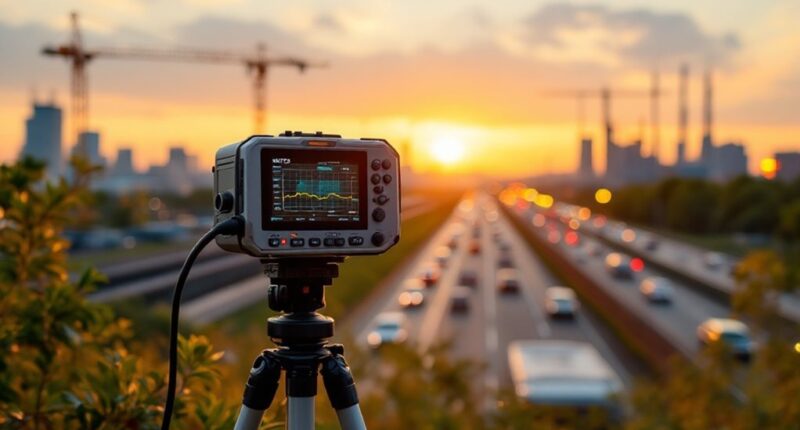Environmental noise monitoring employs specialized equipment to measure sound levels from traffic, construction, and industrial sources. Sound level meters capture metrics like LAeq and LA90, establishing baseline conditions for comparison. Predictive models such as ISO 9613 and SoundPLAN forecast future noise impacts, while assessment criteria align with WHO guidelines. Mitigation strategies address noise at its source, along its path, or at the receiver. The challenges of low-frequency sound and cumulative impacts shape this evolving field of environmental protection.

The symphony of unwanted sound surrounds modern life, from rumbling traffic and construction clamor to the persistent hum of industrial facilities. This acoustic tapestry—while often overlooked—carries significant implications for human health and environmental quality. Environmental noise monitoring has evolved into a sophisticated science, blending technical precision with practical applications to safeguard our sonic landscape.
The process begins with a detective-like hunt for noise sources and receptors—those unfortunate ears (human or otherwise) on the receiving end. Specialists establish baseline conditions using sound level meters that capture metrics like LAeq (think of it as noise’s “average weight”) and LA90 (the background noise that’s always hanging around, like that friend who never leaves your party). These acoustic snapshots create the “before” picture in any impact assessment. Prolonged exposure to these noise sources can lead to serious health impacts including stress, anxiety, and hearing loss, particularly affecting vulnerable populations.
Acoustic detectives track down sound culprits and capture noise fingerprints before they disturb the peace of unsuspecting ears.
Predicting future noise levels is where the real wizardry happens. Using software tools that would make any tech enthusiast drool, analysts model sound propagation through complex environments. Models like ISO 9613 and SoundPLAN act as crystal balls, forecasting how that new highway or wind farm might transform the acoustic environment. It’s like weather prediction, but for noise storms.
The crux of assessment lies in comparing these predictions against established criteria. The World Health Organization has drawn lines in the sand regarding what constitutes acceptable noise exposure—much like nutritionists setting recommended daily allowances, but for your ears instead of your stomach.
When noise levels cross these thresholds, mitigation strategies enter the picture. These range from source-based solutions (muffling the offender) to transmission path interventions (throwing up barriers) to receiver protections (upgrading windows). It’s a toolkit as varied as the noises themselves.
Challenges abound in this field—low-frequency vibrations that dodge conventional measurement, the subjective nature of annoyance, and the cumulative impact of multiple noise sources creating an acoustic pile-up. Many monitoring projects employ devices like the NoisePen Dosemeter to accurately track personal sound exposure in both workplace and environmental settings. Environmental noise assessment isn’t just about decibels—it’s about preserving the delicate balance between human activity and acoustic livability.
Frequently Asked Questions
How Does Weather Affect Environmental Noise Measurements?
Weather substantially influences environmental noise measurements in multiple ways. Wind above 5 m/s causes severe distortions, with downwind propagation increasing noise levels while upwind conditions decrease them by up to 20 dB.
Temperature gradients alter sound wave refraction, with inversions extending sound travel. Humidity affects sound absorption—higher humidity preserves sound waves while dry conditions accelerate dissipation.
Precipitation also impacts readings: rain increases ambient noise while snow absorbs sound. These variables necessitate careful documentation during measurement procedures.
What Are the Costs of Implementing Noise Monitoring Systems?
Implementing noise monitoring systems involves substantial investment. Equipment costs range from $2,500 for basic sound level monitors to $15,000 for sophisticated systems, with weather-protected and solar-powered options adding $3,000-$6,000.
Installation expenses include site surveys ($500-$2,000), mounting hardware ($200-$500), and professional setup ($500-$1,500).
Ongoing costs encompass calibration services ($200-$500 annually), data storage ($20-$100 monthly), and maintenance (5-10% of equipment cost yearly). Training and reporting services represent additional long-term expenses.
Who Is Responsible for Enforcing Noise Regulations?
Noise regulation enforcement operates as a multi-tiered system. At the federal level, the EPA coordinates overall efforts, while specialized agencies like the FAA and OSHA enforce sector-specific standards.
State environmental agencies develop and implement regional regulations. The heavy lifting often falls to local governments through municipal ordinances enforced by police departments and health officials.
Responsibility also extends to entities generating noise, such as airport operators, industrial facilities, and entertainment venues that must self-regulate their sound emissions.
Can Individuals Contribute to Community Noise Monitoring Efforts?
Individuals can notably contribute to community noise monitoring efforts through various accessible methods. By using smartphone apps like Decibel X, residents can collect and share decibel readings to create detailed noise maps.
Many participate in citizen science initiatives such as NOISE, where they record measurements and personal experiences. Wearing personal noise-exposure meters or joining monitoring events further enhances data collection. These contributions improve spatial coverage, provide real-time data, and empower communities to advocate for effective noise reduction strategies.
How Do Cultural Factors Influence Noise Perception and Tolerance?
Cultural factors profoundly shape noise perception and tolerance. High-context cultures often accept implicit background noise, while low-context societies prefer quieter environments. Collectivist communities typically tolerate communal sounds better than individualist ones.
Demographics matter too—older adults and women generally show higher noise sensitivity. Cultural backgrounds influence responses: Germans might confront noise directly, while Japanese individuals tend to endure it for social harmony. These differences highlight why universal noise standards often fall short in diverse communities.









